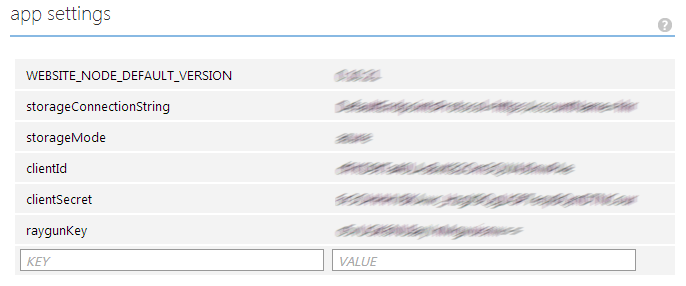Configuring Azure Web Jobs by Mark Seemann
It's easy to configure Azure Web Jobs written in .NET.
Azure Web Jobs is a nice feature for Azure Web Sites, because it enables you to bundle a background worker, scheduled batch job, etc. together with your Web Site. It turns out that this feature works pretty well, but it's not particularly well-documented, so I wanted to share a few nice features I've discovered while using them.
You can write a Web Job as a simple Command Line executable, but if you can supply command-line arguments to it, I have yet to discover how to do that. A good alternative is an app.config file with configuration settings, but it can be a hassle to deal with various configuration settings across different deployment environments. There's a simple solution to that.
CloudConfigurationManager #
If you use CloudConfigurationManager.GetSetting, configuration settings are read using various fallback mechanisms. The CloudConfigurationManager class is poorly documented, and I couldn't find documentation for the current version, but one documentation page about a deprecated version sums it up well enough:
"The GetSetting method reads the configuration setting value from the appropriate configuration store. If the application is running as a .NET Web application, the GetSetting method will return the setting value from the Web.config or app.config file. If the application is running in Windows Azure Cloud Service or in a Windows Azure Website, the GetSetting will return the setting value from the ServiceConfiguration.cscfg."That is probably still true, but I've found that it actually does more than that. As far as I can tell, it attempts to read configuration settings in this prioritized order:
- Try to find the configuration value in the Web Site's online configuration (see below).
- Try to find the configuration value in the .cscfg file.
- Try to find the configuration value in the app.config file or web.config file.

(It's possible that, under the hood, this UI actually maintains an auto-generated .cscfg file, in which case the first two bullet points above turn out to be one and the same.)
This is a really nice feature, because it means that you can push your deployments directly from your source control system (I use Git), and leave your configuration files empty in source control:
<appSettings> <add key="timeout" value="0:01:00" /> <add key="estimatedDuration" value="0:00:02" /> <add key="toleranceFactor" value="2" /> <add key="idleTime" value="0:00:05" /> <add key="storageMode" value="files" /> <add key="storageConnectionString" value="" /> <add key="raygunKey" value="" /> </appSettings>
Instead of having to figure out how to manage or merge those super-secret keys in the build system, you can simply shortcut the whole issue by not involving those keys in your build system; they're only stored in Azure - where you can't avoid having them anyway, because your system needs them in order to work.
Usage #
It's easy to use CloudConfigurationManager: instead of getting your configuration values with ConfigurationManager.AppSettings, you use CloudConfigurationManager.GetSetting:
let clientId = CloudConfigurationManager.GetSetting "clientId"
The CloudConfigurationManager class isn't part of the .NET Base Class Library, but you can easily add it from NuGet; it's called Microsoft.WindowsAzure.ConfigurationManager. The Azure SDK isn't required - it's just a stand-alone library with no dependencies, so I happily add it to my Composition Root when I know I'm going to deploy to an Azure Web Site.
Web Jobs #
Although I haven't found any documentation to that effect yet, a .NET console application running as an Azure Web Job will pick up configuration settings in the way described above. On other words, it shares configuration values with the web site that it's part of. That's darn useful.

Comments
Howard, thank you for writing. You should always keep your secrets out of source control. In some projects, I've used web.config transforms for that purpose. Leave your checked-in
.configfiles empty, and have local (not checked-in).configfiles on development machines, production servers, and so on.As far as I know, on most other platforms, people simply use environment variables instead of configuration files. To me, that sounds like a simple solution to the problem.